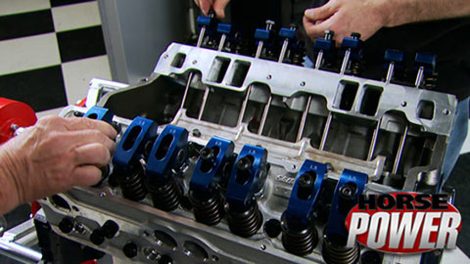HorsePower Builds
Want more content like this?
Join the PowerNation Email NewsletterParts Used In This Episode
Summit Racing
Camshaft, Hydraulic Roller Tappet, Advertised Duration 296/300, Lift .539/.548, Chevy, 5.0, 5.7L., Lifters, Hydraulic Roller, Chevy, Small Block, V6.
Summit Racing
Carburetor, Summit, 750 cfm, Square Bore, 4-Barrel, Manual Choke, Mechanical Secondary.
Summit Racing
Cylinder Head Bolts, Hex Head, Chevy, Small Block, Stock, Edelbrock Performer/RPM Heads, Kit.
Summit Racing
Cylinder Head, Performer RPM, Aluminum, Assembled, 64cc Chamber, 185cc Intake Runner.
Summit Racing
Distributor, Blueprinted HEI, Magnetic Pickup, Adjustable Vacuum Advance, Black Cap, Chevy, Big/Small Block., Spark Plug Wires, Spiro Wound, 8mm, Blue, 90 Degree Boots, GM, V8., Distributor Hold-Down Clamp, Steel, Chrome, Bolt Mount, Chevy, Small/Big Block., Distributor Gear, Aluminum, Bronze, Race, .491 in. Diameter Shaft, Small Block, Big Block, V6
Summit Racing
Eagle Specialty Products Balanced Rotating Assembly, Street, Cast Crank, Hypereutectic Pistons, I-Beam Rods, Chevy, Small Block, Kit., Eagle rotating kits feature a crankshaft and connecting rods, Sealed Power pistons, Perfect Circle piston rings, Mahle-Clevite rod and main bearings and 168 tooth flexplate for automatic transmission and harmonic balancer.
Summit Racing
Engine Block, Cast Iron, 4-Bolt Mains, 4.030 in. Diameter Bore, 1-Piece Rear Main Seal, Chevy, Small Block,383.
Summit Racing
Intake Manifold, Stage 3, Dual Plane, Aluminum, Natural, Square Bore Flange, Chevy, Small Block 1955-86.
Summit Racing
Moroso Oil Pan, Steel, Clear Zinc, 6 qt., Chevy, Small Block., Moroso Oil Pickup, Press Fit, Aftermarket Pan Style, Chevy, Small Block.
Summit Racing
Rocker Arms, Stud Mount, Full Roller, Aluminum, 1.5 Ratio, Fits 3/8 in. Stud, Chevy, Small Block, Set of 16.
Summit Racing
Timing Chain and Gear Set, Performer-Link, Double Roller, Iron/Steel Sprockets, Chevy, V6/Small Block.
Summit Racing
Timing Cover, 1-Piece, Steel, Chrome Plated, Chevy, Small Block., Timing Pointer, Steel, Chrome, 6.75/7.0/8.0 in. Balancers, Chevy, Small Block.
Summit Racing
Valve Covers, Tall, Steel, Chrome, Plain, Chevy, Small Block., Valve Cover Breather, Push-In, Round, Steel, Chrome., Valve Cover Grommet, PCV, 1.22 in. Outside Diameter, .75 in. Inside Diameter., Oil Fill Cap, Steel, Round, Chrome, Push-In, Universal, Summit Logo., Valve Cover Wing Nuts, Extra Long, 1/4-20 Thread, 5 in. Long, Chrome, Set of 4. takes two packs, Valve Cover Gaskets, Rubber with Steel Core, Chevy, Small Block.
Summit Racing
Water Pump Pulley, V-Belt, 1-Groove, Steel, Chrome, Chevy, Small Block, Short Pump., Crankshaft Pulley, V-Belt, 1-Groove, 6.76 in., Steel, Chrome, Chevy, Small Block, Short Pump.
Summit Racing
Water Pump, Mechanical, Short, High-Volume, Iron, Black Powdercoated, Chevy, Small Block.
[none]
Royal Purple Motor Oil delivers superior protection and improves performance in four-cycle gasoline and diesel engines. It increases horsepower and torque, saves fuels and reduces heat, wear and emissions.
[none]
Royal Purple oil filters provide superior particle removal, high-performance and optimized flow characteristics for maximum performance and longer filter life.
CounterAct
CounterAct electronic rust protection is demonstrably different from more traditional forms of electronic rust protection because it was designed from the outset to operate in a free open air environment unlike traditional electronic rust protection methods which require a relatively abundant moisture content in a continuous layer on or near the metal object being protected. The point is the ability of traditional electronic rust protection to inhibit rust and corrosion ends at the waterline or
O'Reilly Auto Parts
Champion Spark Plugs (8)
RapidAir Products
RapidAir offers an easy and flexible way to customize your workshop with applications from automotive to woodworking. RapidAir is a complete compressed air distribution system that is designed to easily install beneath walls of new construction, or on wall surfaces of existing workshops. Our garage compressed air piping system is designed for a lifetime of service.
Tennessee Speed Sport
Pushrods, High Energy, Steel, Heat-Treated, 5/16 in. Diameter, 7.290 in. Length, Universal, Set of 16.





























